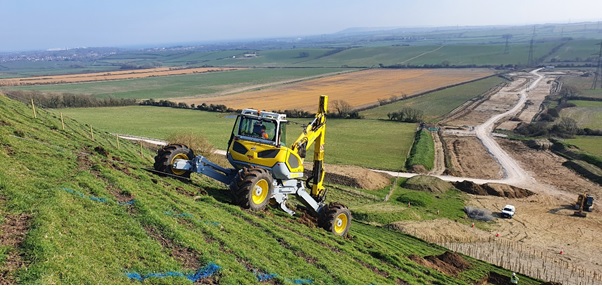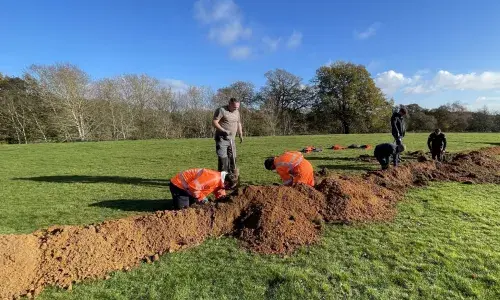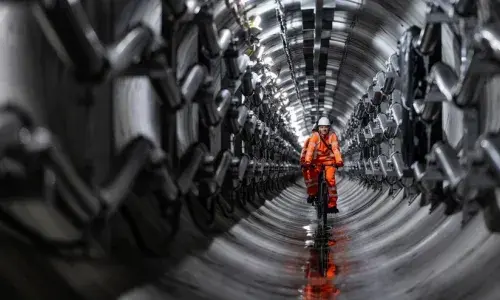
Dorset’s spidermen show skilful engineering as National Grid project nears completion
- National Grid achieves significant milestones in the build up to Dorset pylon removal
- Going Underground project uses specialist machinery more at home on the Swiss Alps
- Underground cables have been tested and natural landscape profiles restored as the first of National Grid’s Visual Impact Provision projects nears completion
National Grid is celebrating significant milestones as part of its Visual Impact Provision to remove overhead cables and pylons across the Dorset landscape.
The Going Underground* project is replacing 22 pylons and 8.8km of wires with underground cables, transforming the views of the Dorset Area of Outstanding Natural Beauty (AONB) near the villages of Martinstown and Winterbourne Abbas. It's one of the first projects in the world to remove existing high-voltage electricity transmission infrastructure solely to enhance the landscape.
In its latest milestone, after three years of construction and expert engineering, the site team has successfully completed high-voltage testing of one of the two cable circuits now buried underground.
The cables are manufactured, transported and laid in sections of 1km at a time, and connecting these together requires precise technical engineering in environmentally secure conditions.
More than half of the 108 kilometres of cable has now been tested, with full circuit testing due to be complete by 7 June.
With all cables laid, National Grid has also been working to restore the site’s land to the way it was before work began.
When National Grid first started work in autumn 2019, an exact scan of the undulations and tracks present on the hillside was taken, enabling this hill to be returned precisely to its original state. Specialist equipment, including a ‘spider digger’, has been essential on the steep slopes of Corton Hill throughout the process; from installing ducting and pulling cables to restoring the natural landforms and ridges of the hillside.
Paul Hamnett, Senior Project Manager for National Grid said: "The steep slopes of the Dorset Area of Outstanding Natural Beauty are part of what makes this landscape so beautiful, but they have also challenged our team. One particular incline was so steep, we had to bring in a specialist machine more at home on the Alps in Switzerland.
“The notoriously sharp gradient of Corton Hill meant we had to anchor a spider digger to the hill during operation to ensure the safety of all involved.
“The incredible team on this project has once again shown complete mastery of these challenging landscapes and the specialist machinery required to work here. Congratulations to our own VIP spidermen!
“None of this would have been possible without the dedication and expertise of the site team and the patience of the local community. We will soon begin final commissioning of the second circuit and can then turn our attention to everything we’ve been working towards – the removal of the pylons in just a few months’ time.”
Tom Munro, manager for the Dorset AONB Partnership, added: “This is a big step forwards to removing the pylons from the nationally-important Dorset landscape. It’s been great to see this world-first project progress first-hand and I’d like to thank all those involved for their expertise and support in our shared goal of enhancing the natural beauty of this special place.”
The section was chosen by the national Stakeholder Advisory Group from hundreds of alternatives following a comprehensive, independent survey across AONBs and National Parks in England and Wales. It's one of only four in England and Wales, alongside others in the Peak District National Park, the North Wessex Downs AONB and Eryri (Snowdonia) National Park.
The pylons are due to be removed later this year.
Media contact:
Helen Blake +44 7790 824788
*About Going Underground – Visual Impact Provision project
Going Underground is part of National Grid’s Visual Impact Provision (VIP) project, which is a national stakeholder-led programme to reduce the visual impact of existing high voltage power lines in Areas of Outstanding Natural Beauty and National Parks across England and Wales.
All electricity transmission owners are funded by a price control mechanism which is agreed with and set by Ofgem, the electricity and gas markets regulator. Ofgem has agreed a set of price controls and incentives for the period from April 2021 to March 2026. The price controls and incentives include a provision to mitigate the visual impact of existing electricity infrastructure in nationally protected landscapes in Great Britain.
For National Grid, which is the electricity transmission owner in England and Wales, this means considering the visual amenity of our existing infrastructure in Areas of Outstanding Natural Beauty (AONBs) and National Parks.
About the Dorset Area of Outstanding Natural Beauty:The Dorset Area of Outstanding Natural Beauty covers over 40% of Dorset, stretching from Lyme Regis in the west, along the coast to Poole Harbour in the east, and north to Hambledon Hill near Blandford Forum. The Dorset AONB Partnership brings together 20 organisations to conserve and enhance the natural beauty of this nationally important protected landscape. Find out more about the Dorset AONB and the work of the Partnership at www.dorsetaonb.org.uk.
Areas of Outstanding Natural Beauty (AONBs) are exceptional landscapes whose distinctive character and natural beauty are precious enough to be safeguarded in the national interest. The Dorset Area of Outstanding Natural Beauty is one of 46 AONBs in the UK, protected and enhanced for nature, people, business and culture. For further information about the AONB network visit www.landscapesforlife.org.uk


